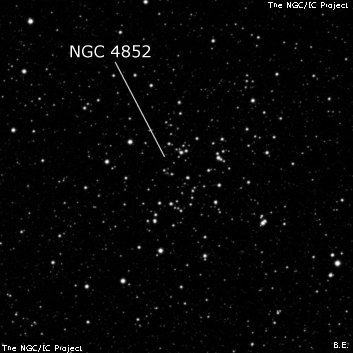
James Dunlop discovered NGC 4852 = D 311 = h3449 on 30 Apr 1826 with his 9-inch reflector from Parramatta, New South Wales, and recorded "a very faint pretty large nebula about 6' or 8' diameter, round figure, resolvable into very minute stars. Several stars of some considerable magnitude appear scattered among the minute stars of the nebula, but they are only the continuation of a branch of small stars which run over the place where the nebula is; the stars in the nebula are very gradually, but not much, compressed to the centre." He observed the cluster of 4 times and his catalogued position is ~8' SE of the center of the cluster.
On 31 Mar 1834, JH recorded "a very poor cluster of about 70 stars 11..15th magnitude, very loosely scattered over a space about 15' long and 8' br." His second observation reads "Cluster VII. p rich, L, irr R, 10' diameter, 80 or 100 stars, 10, 11, 12 mag, with a stippling of much smaller ones."
600/800mm - 24" (4/12/08 - Magellan Observatory, Australia): I'm surprised I didn't look for this cluster previously from Australia or Costa Rica as it is located just 1.1° NE of the Jewel Box and 1.6° east of mag 1.3 Beta Crucis! At 200x it was a pretty impressive collection of ~150 stars mag 10-16 in a 10' region including several mag 10-10.5 stars. One subgroup makes a neat "zig-zag" or "M" outline while another set of stars forms a "V" shaped group. There are no real rich subgroups but still it forms a nice cluster.
Notes by Steve Gottlieb